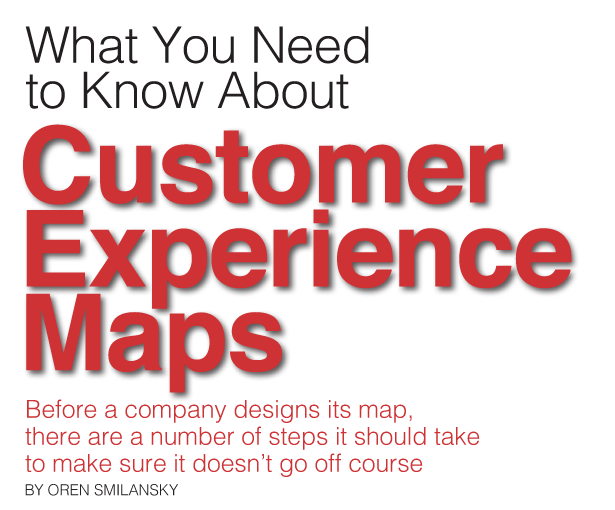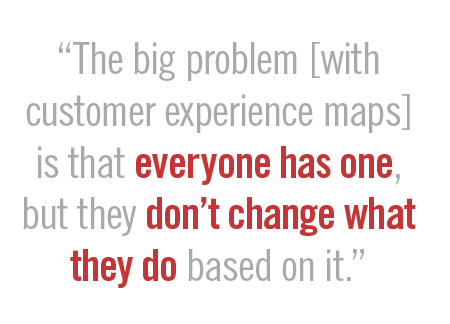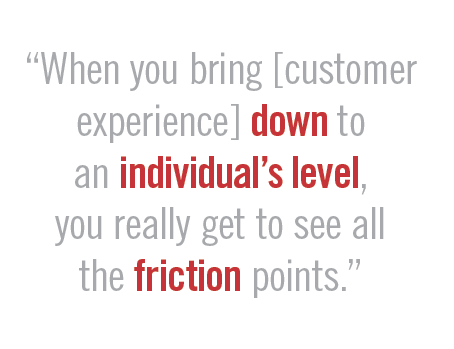

Before a company designs its map, there are a number of steps it should take to make sure it doesn't go off course
BY OREN SMILANSKY





Customer experience (CX) has been getting people’s attention lately. “The new battlefield,” declared a post on Gartner’s website this past February, noting that 89 percent of the companies surveyed by the research firm believe that CX will be their primary area of competition by 2016.
This suggests that leaders are becoming increasingly concerned with ensuring the customer enjoys each interaction with its company. Yet, at the same time, it’s getting harder to make sure those experiences are positive. And as the voices of the customers become more readily heard, it’s vital that those customers be served properly during every interaction they have with a company, lest they be left with a bad impression that scares them away for good.
Every false move has the potential to alienate customers, whose number of contact points with companies is higher than one would think. Whether it’s online, on the phone, in the store, or even while viewing the dreaded bill, customers are forming impressions all the time. And though the moment that stands out the most—and everyone’s favorite to imagine—is the moment at which the customer hands over cold, hard cash in exchange for the goods or services she desires, many steps lead up to, and follow, that interaction. These steps are often easy to forget about or neglect, so it’s important that companies make a concerted effort to keep up.
Unfortunately, the reality is that visualizing the steps a customer takes, and recognizing just how many there actually are, can be a challenge. Many of us are visual creatures, so it helps to see how things play out on paper instead of holding them all in mind. It might be helpful to think of the customer as a character in a board game, and the company the designer leading the way. It’s the company’s duty to make sure that character proceeds though the board successfully and meets their ultimate objective.
When the board game is levels more difficult than it needs to be, the customer won’t always be willing to play along—especially if a competitor is offering an easier game. That’s where customer experience maps come in handy, as they can give company leaders a way of keeping track. It’s important to take careful steps in creating a map that will be of assistance to the company. After all, a board game that’s impossible to play will not stay on shelves for long, and a customer experience that draws the customer away from his goal is likely to make him give up.
If we’re going to continue with the board game metaphor, an important distinction must be made. Unlike in a board game, the CX journey should be as straightforward as possible, with no unnecessary complications, if you are to keep the participant engaged and happy. In these pages, we offer tips for companies that are considering implementing customer experience maps to help customers on the journey leading up to and following a purchase.
The Basic Ingredients
Customer experience maps should all have three things in common, according to Tony Costa, senior analyst at Forrester Research. First, regardless of the form a map takes, it must include a series of tasks or activities. For example, a customer might research a product online before going to a store, or return a product to the store if it is damaged. These signify activities—what the customer is trying to accomplish.
Second, a map should include touch-points—or points of contact—where the customer interacts with the company or brand in question. The touch-points are not always that easy to identify. A store and a Web site are obvious ones, but some are less so, like peers: People are likely to take product advice from a trusted friend seriously.
Last, and perhaps the most important, it should include the type of emotion the customer expresses or feels during each of these stages. If a 20-something male is feeling annoyed in the car dealership’s waiting room because Barney reruns are playing on a low-quality TV, the experience should be noted. And companies should try to factor in relevant information about the external conditions a person experiences during a task or touch-point.
How Should it Look?
You might say that customer experience maps are all over the map. One might look drastically different from the next. Some take the form of closed loops, others are more linear; some are color-coded, others black and white. No matter the shape, a map should be pleasing to look at, since you’ll be expecting a team to consult it frequently to better understand how to operate.
Travel-lodging company Airbnb took this seriously, going so far as to hire a Pixar animator to illustrate its map. An enterprise that enables people to rent out their living space online as a cheaper alternative to hotel rooms, it has to consider multiple types of customers. Those who use the website to post their offerings, though playing the part of seller, are also a customer of sorts, as they are expecting service from the website. Likewise, those renting out the space are another type of customer. Airbnb used Disney’s Snow White as a model for its map, and the idea of storyboarding as an inspiration for how to illustrate the processes.
It’s easy to forget that the members of a company are also a form of customer themselves, but workers are also seeking the path of least resistance. If you can provide a good experience to users when they’re consulting the map—which will help them understand the various parts of the company and how they should be working together—that’s just more incentive for them to use it.
Why Create One, and What Is It For?
The reasons for creating a CX map might seem obvious. You create a customer experience map with the ultimate goal of better understanding your customer and improving his experience in some way. Right? Well, sort of. Though that’s the idea, it’s also not as ideal or easy to reach as it should be.
Businesses should think through the areas that give their customers the most challenges. This way, they will avoid spending time, money, and effort on something that they probably won’t use—which happens more often than it should, experienced thinkers in the industry point out. “The big problem [with customer experience maps] is that everyone has one, but they don’t change what they do based on it,” says Larry Augustin, CEO of SugarCRM, who delivered a presentation on customer journey mapping at the Customer Experience Conference in March.
One way of avoiding this potential hurdle is to have a specific goal in mind. Experts recommend that companies have a clear idea of how they’re going to use their map, and to what end. If, for instance, a company’s objective is to improve brand perception, it should create a map that focuses on sharpening any interactions that pertain to that sphere. If it wants to improve customer pain points, it should focus on the customers’ emotions and thoughts during those interactions.
How to Get Started
No two companies are alike. Similarly, no two customer experience maps are exactly alike. Each map must be tailored specifically to meet the needs of the company in question. No matter how similar two companies are, they should never expect that they can duplicate another company’s customer experience map and implement the same strategies to the same effect.
For starters, it’s a good idea to understand as much as possible about the clientele. Who is your company trying to appeal to with its products or services? How well is your company catering to them?
Feedback collected through various forms of customer surveys is vital to the process, says Jill Hewitt, user experience designer at Catalyst, a marketing agency that focuses on improving customer relationships for Fortune 1,000 companies. One great way to gather pertinent info, Hewitt says, is through customer interviews and online focus groups. The benefit of having online groups, she maintains, is that they don’t allow for “groupthink,” and are the perfect forum for honest criticism since the participants generally don’t have access to other commenters’ complaints until they’ve submitted their own. After sufficient feedback has been collected and coupled with demographic information, these criticisms can help organizations determine which experiences are trends versus anomalies. Companies can then use this information to determine what stages of the customer journey present the biggest challenges and draw up composite characters who confront these recurring issues.
Will a User Map Help a Company Please Everyone?
One thing to remember is that, try as a company might, not everything concerning customer experience is going to be in its hands—there will always be outside factors that cannot be controlled. With an airline, for example, a number of issues could arise that affect a passenger’s travel experience. During a storm, it’s highly likely that a flight will be delayed. If there are babies on the plane, their crying might keep the passenger up.
What companies can do, however, is to make sure those understandable and likely disturbances are addressed as well as they can be. JetBlue offers earplugs and sleep masks to each of its flyers; US Airways does not. These represent clear choices both companies have made, preferences they’ve expressed for certain clientele. On the other hand, US Airways often makes a concerted effort to put families seated in different aisles together by asking passengers traveling alone whether they’re willing to switch seats and be compensated with a free drink. In these cases, it’s quite apparent which airline offers the better experience for passengers seeking a quiet and comfortable flight, and which airline caters to passengers flying with family members.
It’s important that companies figure out who their most valued customers are, and what they can do to appeal to those customers in any given situation.
Customer Journey Maps Versus Customer Experience Maps
One way to identify your key customers is by crafting personas and customer journey maps, which take into consideration experiences that a great number of typical customers are going through.
Constructing personas based on customer archetypes can be hugely beneficial to companies. For one thing, it can help them figure out the customer segments (by demographics, behaviors, personality types, etc.) they truly need to focus on. It also helps with sharpening the focus of customer experience maps. Likewise, it lets stakeholders in the company put a face to the hypothetical customer by giving him or her a tangible identity. “When you think about experiences at a generic level, you sort of lose all the texture and the grit of what the customers really go through,” Forrester’s Costa says. “When you bring it down to an individual’s level, you really get to see all the ups and downs, the emotional states, the friction points, [and] the pain in the experience that they come out with.” Some journey maps even include headshots or illustrations representing the customer, just to remind the employee consulting the map that there are actual people going through these troubles.
A mistake people often make is in assuming that customer journey maps and customer experience maps are the same thing. There are distinctions, Costa points out. The customer journey map, he explains, is typically more concerned with one person’s attempt to achieve a specific goal.
A Starbucks customer journey map available online illustrates the typical experience of a young man, dubbed “Eric,” as he tries to get coffee. Eric, a male college student, enters the crowded store located near his campus with the intention of getting a drink and sitting down for a few hours to study. Along the way, he has a number of reactions to the stages he undergoes before sitting down with his beverage. Upon entering, he notices there aren’t many seats available, which is a concern. While he’s waiting in line, he feels rushed because the baristas and cashiers are working quickly to keep the customers moving along and getting their drinks, so he doesn’t take much time to read the drink menu and customize his order. Though he’s able to find a place to sit and study, while enjoying the added benefits of the Starbucks environment (people-watching and music), he also isn’t pleased that the store closes at 10 p.m. and he’s forced to relocate and find a new study spot.
These are important factors to keep in mind, if Eric makes up a large portion of the company’s clientele. But if he represents a negligible percentage of the customer base, his experience might not be worth paying close attention to.
Hewitt suggests it’s important to have a manageable number of ideal customers, and that typically the number happens to be between five and seven. Starbucks seems to be doing well enough as a whole, so for every Eric, it stands to reason that there’s a George or Karly who is satisfied with their experience. Karly, a hypothetical longtime customer, might know exactly what drink she wants before even getting to the store, so she might appreciate that the line moves quickly and doesn’t wait for newbies. Furthermore, her drink also might be more expensive than Eric’s plain coffee. She might not want to stick around, but is just picking it up before studying at home.
Because there are so many types of customers, and plenty of angles from which companies can approach the customer experience map, having multiple journey maps isn’t necessarily a bad idea. It helps to keep track of the areas of experience a company should focus on. This information can all be applied later to the customer experience map, which covers the overall relationship of companies companies to customers, beginning with their first interaction with a brand and ending with their final goodbyes.
The Dangers of a Map
As with any map, the main thing users want to avoid is being led astray. Customer experience maps are called customer experience maps and not company assistance maps for good reason. The idea is to help the customers—to offer them an enjoyable and simplified process whenever they interact with you. To get back to the board game metaphor: We can’t treat customers like pieces we’re moving with our hand, and thus take away their agency.
One of the pitfalls with maps, warns Esteban Kolsky, principal and founder of ThinkJar LLC, a customer strategy consultancy, is that companies lose sight of the customer when they’re creating them. “Instead of letting the customer do what they want to do, we give them options, but they are controlled options, so we know what’s going to happen and what we need to do, and as a company we think we’re more in control. But, at the end, the customer doesn’t get what they need, which is they need to create their experiences any way they want.”
In other words, we shouldn’t ever compel customers to do things in a way that is most convenient for us, simply because that’s the way it was laid out for us on a map. If there’s one thing a company should avoid doing, it is to create a map that puts down a restrictive path—one that customers must follow to get their desired outcome. ![]()
Associate Editor Oren Smilansky can be reached at osmilansky@infotoday.com.